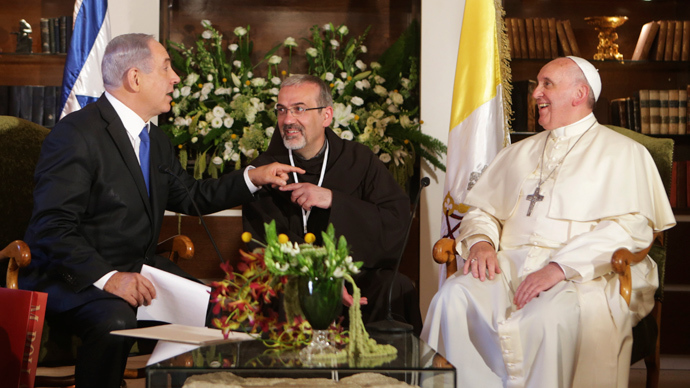So as a reader of this site you’ve very likely heard that Pope Francis and Israeli Prime Minister Benjamin Netanyahu had a small friendly disagreement over the language that Jesus spoke.
During his comments about a strong connection between Judaism and Christianity and tolerance towards Christians in Israel, Netanyahu told the Francis: “Jesus was here, in this land. He spoke Hebrew.”
“Aramaic,” the pontiff interjected.
“He spoke Aramaic, but he knew Hebrew,” Netanyahu shot back.
(RT.com)
I’m with both of them, as it were. Hebrew in Jesus’ day was certainly spoken, but it was mostly used as either a scholarly language or as a language of nationalists and zealots (such as during the Bar Kochba Revolt). One must assume that Jesus had enough command of Hebrew to engage the scribes and Rabbis of the era effectively (where the debates were probably in Aramaic about Hebrew passages).
However, outside of scholarship and nationalism, the common language was Aramaic, and the plainest example of this on Jesus’ lips comes from the famous, very distinctly Aramaic phrase Eli Eli lama sabachthani (= אלי אלי למה שבקתני). If it were Hebrew, we would have seen azavthani (which is what appears in Psalms) rather than sabachthani.
Granted, a common retort is that he could have been speaking in Mishnaic Hebrew, a Hebrew dialect that was used by Rabbinical writings in a nearly contemporary period which contained a large number of Aramaic loan words, spellings, and even loan grammar. However, the existence of this loan material from Aramaic shows how predominant Aramaic had become to the point of its drammatic effect upon the Hebrew of the day. Mishnaic Hebrew, in this sense, was more like Medieval Latin was in European scholarship: It was “modernized” (for the time), no one really spoke such a dialect at home, but the majority of scholarly works were written in it.
The Bar Kochba Revolt is often cited as a prime example of Hebrew as a living language contemporary to Jesus, due to a large amount of correspondence that has survived in Mishnaic Hebrew. However, this turns out to have been a purposeful adoption by Simon Bar Kochba as an expression of Jewish identity, for we can see that all of the early letters that survive from the Revolt (which took place 100 years after Jesus’ time between 132-135 AD) are in Aramaic where all of the later ones are in Hebrew with a period of transition in the middle.
Finally, where Mishnaic Hebrew predominantly developed in Judea paired with Eastern Aramaic speakers, Jesus was a Galilean, and the Galilean mode of speech was a very distinct dialect of Western Aramaic (which you can read more about here). As an illustrative example, between the two Talmuds — Bavli or “Babylonian Talmud” in Eastern Aramaic and Yerushalemi or “Palestinian Talmud” in Western Aramaic — the bulk of the Mishnaic Hebrew corpus comes from Bavli, where Yerushalemi (the earlier of the two) prefers keeping nearly all of its earliest commentary in Aramaic.
In any case, the two languages in Jesus’ day were inexorably linked. They were a part of the very fabric of Christ’s culture and were an integral part of the liturgy recited on every Sabbath in every synagogue during his ministry.
Peace,
-Steve
